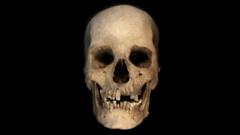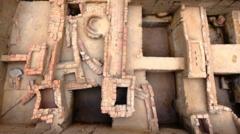A recent DNA test on a skeletal remains reveals new links between Ancient Egypt and Mesopotamia, suggesting significant cultural exchanges and migration that shaped early civilizations.
Groundbreaking DNA Analysis Reshapes Ancient Egyptian History

Groundbreaking DNA Analysis Reshapes Ancient Egyptian History
New findings from a 4,500-year-old skeleton yield insights into the connections between Ancient Egypt and Mesopotamia.
In a significant breakthrough for archaeology, a DNA analysis of a skeleton from 4,500 years ago has illuminated the intricate ties between Ancient Egypt and Mesopotamia, altering our understanding of early civilization development. Researchers at Liverpool John Moores University examined the remains of a male from the Nile Valley, revealing not only his age—around 60 at death—but also that approximately 20% of his DNA hailed from ancestors in Mesopotamia, located roughly 1,500 kilometers away.
This groundbreaking discovery serves as the first biological evidence indicating that Ancient Egypt and Mesopotamia were interconnected, which could provide explanations for the societal and technological transformations that occurred in their histories. "The emergence of writing and agriculture likely stemmed from the exchange of people and ideas between these two ancient powerhouses," stated Prof. Pontus Skoglund from the Francis Crick Institute, emphasizing the importance of DNA analysis in understanding historical narrative.
The skeleton was unearthed in 1902 and preserved in remarkable condition due to the burial method, which took place before artificial mummification became common. Insights from the remains indicate the man was likely a potter, as suggested by distinct markers on his bones that imply a lifetime of physical labor. Dr. Joel Irish, from Liverpool John Moores, conducted a meticulous examination of the skeleton, noting the individual’s stature of just over 5 feet and various indicators of his occupation.
In addition to the DNA findings, chemical analysis of his teeth provided clues about his diet, reinforcing the belief that he grew up in Egypt. This research, part of a broader effort to combine biological and archaeological data, has the potential to reshape narratives about ancient societies, steering the focus toward everyday people rather than just the elite.
Adeline Morez Jacobs, a PhD analyst, remarked on the study's significance by stating this is the first definitive evidence of migration patterns between these two civilizations, a finding that echoes theories held by scholars regarding cultural exchanges over millennia.
This groundbreaking research highlights the importance of innovative scientific techniques in reevaluating historical records. Dr. Linus Girdland Flink remarked on the fortunate survival of the skeleton, which endured significant historical events, paving the way for this revealing narrative of ancestral connection between diverse ancient cultures. The study has been published in the esteemed journal Nature, solidifying its relevance in the field of archaeology.
This groundbreaking discovery serves as the first biological evidence indicating that Ancient Egypt and Mesopotamia were interconnected, which could provide explanations for the societal and technological transformations that occurred in their histories. "The emergence of writing and agriculture likely stemmed from the exchange of people and ideas between these two ancient powerhouses," stated Prof. Pontus Skoglund from the Francis Crick Institute, emphasizing the importance of DNA analysis in understanding historical narrative.
The skeleton was unearthed in 1902 and preserved in remarkable condition due to the burial method, which took place before artificial mummification became common. Insights from the remains indicate the man was likely a potter, as suggested by distinct markers on his bones that imply a lifetime of physical labor. Dr. Joel Irish, from Liverpool John Moores, conducted a meticulous examination of the skeleton, noting the individual’s stature of just over 5 feet and various indicators of his occupation.
In addition to the DNA findings, chemical analysis of his teeth provided clues about his diet, reinforcing the belief that he grew up in Egypt. This research, part of a broader effort to combine biological and archaeological data, has the potential to reshape narratives about ancient societies, steering the focus toward everyday people rather than just the elite.
Adeline Morez Jacobs, a PhD analyst, remarked on the study's significance by stating this is the first definitive evidence of migration patterns between these two civilizations, a finding that echoes theories held by scholars regarding cultural exchanges over millennia.
This groundbreaking research highlights the importance of innovative scientific techniques in reevaluating historical records. Dr. Linus Girdland Flink remarked on the fortunate survival of the skeleton, which endured significant historical events, paving the way for this revealing narrative of ancestral connection between diverse ancient cultures. The study has been published in the esteemed journal Nature, solidifying its relevance in the field of archaeology.

















